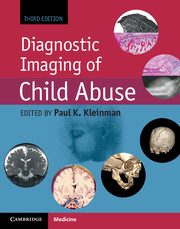Book contents
- Frontmatter
- Dedication
- Contents
- List of Contributors
- Editor’s note on the Foreword to the third edition
- Foreword to the third edition
- Foreword to the second edition
- Foreword to the first edition
- Preface
- Acknowledgments
- List of acronyms
- Introduction
- Section I Skeletal trauma
- Chapter 1 The skeleton: structure, growth and development, and basis of skeletal injury
- Chapter 2 Skeletal trauma: general considerations
- Chapter 3 Lower extremity trauma
- Chapter 4 Upper extremity trauma
- Chapter 5 Bony thoracic trauma
- Chapter 6 Dating fractures
- Chapter 7 Differential diagnosis I: diseases, dysplasias, and syndromes
- Chapter 8 Differential diagnosis II: disorders of calcium and phosphorus metabolism
- Chapter 9 Differential diagnosis III: osteogenesis imperfecta
- Chapter 10 Differential diagnosis IV: accidental trauma
- Chapter 11 Differential diagnosis V: obstetric trauma
- Chapter 12 Differential diagnosis VI: normal variants
- Chapter 13 Evidence-based radiology and child abuse
- Chapter 14 Skeletal imaging strategies
- Chapter 15 Postmortem skeletal imaging
- Section II Abusive head and spinal trauma
- Section III Visceral trauma and miscellaneous abuse and neglect
- Section IV Diagnostic imaging of abuse in societal context
- Section V Technical considerations and dosimetry
- Index
- References
Chapter 5 - Bony thoracic trauma
from Section I - Skeletal trauma
Published online by Cambridge University Press: 05 September 2015
- Frontmatter
- Dedication
- Contents
- List of Contributors
- Editor’s note on the Foreword to the third edition
- Foreword to the third edition
- Foreword to the second edition
- Foreword to the first edition
- Preface
- Acknowledgments
- List of acronyms
- Introduction
- Section I Skeletal trauma
- Chapter 1 The skeleton: structure, growth and development, and basis of skeletal injury
- Chapter 2 Skeletal trauma: general considerations
- Chapter 3 Lower extremity trauma
- Chapter 4 Upper extremity trauma
- Chapter 5 Bony thoracic trauma
- Chapter 6 Dating fractures
- Chapter 7 Differential diagnosis I: diseases, dysplasias, and syndromes
- Chapter 8 Differential diagnosis II: disorders of calcium and phosphorus metabolism
- Chapter 9 Differential diagnosis III: osteogenesis imperfecta
- Chapter 10 Differential diagnosis IV: accidental trauma
- Chapter 11 Differential diagnosis V: obstetric trauma
- Chapter 12 Differential diagnosis VI: normal variants
- Chapter 13 Evidence-based radiology and child abuse
- Chapter 14 Skeletal imaging strategies
- Chapter 15 Postmortem skeletal imaging
- Section II Abusive head and spinal trauma
- Section III Visceral trauma and miscellaneous abuse and neglect
- Section IV Diagnostic imaging of abuse in societal context
- Section V Technical considerations and dosimetry
- Index
- References
Summary
The rib cage
Caffey made no mention of rib fractures when he described the association between subdural hematomas (SDHs) and long bone fractures in abused children in 1946 (1). In fact, it was not until the early 1950s that the importance of rib fractures in the radiologic spectrum of child abuse was appreciated (Fig. 5.1) (2–5). In an interesting recent report, Wheeler et al. described rib fractures and other osseous injuries in the skeletal remains of a 2–3-year-old child from Kellis 2, a Romano-Christian period cemetery in the Dakhleh Oasis, Egypt. The authors suggested that the unusual pattern of skeletal trauma and healing events were due to multiple abusive episodes (6).
The presence of rib fractures is now often central to the radiologic diagnosis of child abuse. A review of the older literature found that rib fractures constituted from 5 to 29% of all fractures detected in children surviving assaults upon them (5, 7–13). More recent data indicate that rib fractures are likely the most common skeletal injuries noted in abused children. In a database review of patients drawn from multiple centers, including postmortem material, Boal et al. found fractures in 213 of 303 (70%) child abuse cases (14). Of a total of 2025 fractures, 1608 (79%) involved the rib cage. In a postmortem study, Kleinman and colleagues found that 51% of all fractures in 31 abused infants who died involved the rib cage (15).
- Type
- Chapter
- Information
- Diagnostic Imaging of Child Abuse , pp. 164 - 207Publisher: Cambridge University PressPrint publication year: 2015
References
- 5
- Cited by



